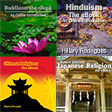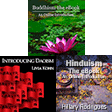Buddhism–The eBook
An Online Introduction
by Charles Prebish and Damien Keown
Buddhism Online:
Self-Test Questions
- The Background to Buddhism
- Self Test Questions
-
- What were the two chief cities of the Indus Valley civilization situated on the river Indus?
- How long did the Indus valley civilization last?
- What role did the Mother Goddess and yoga play in the religion of the Indus Valley?
- What was soma?
- How many Vedas are there, and which is the most important?
- What was innovative about the teachings of the Upani?ads?
- What do the Upanishads mean when they proclaim "Tat tvam asi" and 'Brahmo 'ham"?
- Describe the pattern of social change that was taking place in the Buddha's day.
- What goal did the 'wanderers' (parivrajakas) seek, and what methods did they use to attain it?
- How do Buddhist teachings about the absence of a soul (atman) cause difficulty for the doctrine of karma?
- ↑
- Chapter 1
- Self Test Questions
-
- Name three religions that have a linear view of time.
- What is a kalpa?
- In what months of the year does the monsoon come in India?
- Which Indian texts first mention the idea of reincarnation, and at what date?
- Into which two main categories does Buddhist cosmology divide the universe?
- Which Buddhist text mentioned in this chapter contains a creation myth?
- Can you name the six realms of rebirth?
- How many planes of existence are there in total in the Buddhist universe?
- What is the literal meaning of the word "karma?"
- What is pu.nya?
- ↑
- Chapter 2
- Self Test Questions
-
- Name two textual sources that provide information about the Buddha's life.
- Where was the Buddha born?
- How old was he when he died?
- What were the names of the Buddha's parents?
- What were the "four signs" the Buddha saw when he went outside the palace?
- Did the Buddha have any children?
- How old was the Buddha when he a) renounced the world; b) gained enlightenment?
- Who is Mara?
- What is the English title of the Buddha's first sermon?
- What was done to the Buddha's body after he died?
- ↑
- Chapter 3
- Self Test Questions
-
- What are the "three jewels"?
- What are the three aspects of suffering distinguished in Buddhist texts?
- What three forms of craving are mentioned in the Second Noble Truth?
- What are the two forms of nirvana?
- What is the simplest definition of "nirvana-in-this-life"?
- Why is the Noble Eightfold Path known as the "middle way"?
- What are the four categories of "holy persons" (arya-pudgala)?
- What does "nama-rupa" mean?
- What are the five aggregates (skandhas)?
- What is the meaning of vijñana?
- ↑
- Chapter 4
- Self Test Questions
-
- What are the "three refuges?"
- Describe the ordination procedure for monastics.
- What is the structure of the Vinaya Pi?aka?
- Why is the Pratimoksha so important to the sangha?
- Why does the sangha recite the Pratimoksha twice per month?
- How does the laity support the monastic unit?
- How do the monks and nuns support the laity?
- Why were Ananda and Upali so important to the sangha?
- What is the role of royal patrons for the early sangha?
- Why did the monastic members of the sangha settle down during each rainy season?
- ↑
- Chapter 5
- Self-test Questions
-
- How long did Buddhism exist in India?
- What are the dates of the Magadhan period?
- In what year was Asoka consecrated emperor?
- When and where did the "Third Council" take place?
- Which two groups separated at the "Great Schism?"
- Who were the Vibhajyavadins?
- How many of Asoka's inscriptions have been found to date?
- How was Buddha symbolised in art before the first Buddha-images appeared?
- What is the "Five Buddha Family" system?
- In what year was Nalanda sacked?
- ↑
- Chapter 6
- Self Test Questions
-
- What are the major Prajñaparamita texts?
- What are the major Pure Land Sutras?
- What is Buddha-nature and how does it apply to practitioners?
- Why are wisdom and compassion so important to Mahayana?
- How is the doctrine of emptiness related to dependent origination?
- How are Madhyamika and Yogacara similar? How are they different?
- How is the bodhisattva path different from the path of the arhant?
- What are the "three bodies of the Buddha?"
- Who are the main Mahayana logicians, and why are they important?
- Why do some scholars consider Nagarjuna the greatest Buddhist philosopher?
- ↑
- Chapter 7
- Self Test Questions
-
- What are the main groups of forty meditation topics include in Buddhaghosa's Visuddhimagga?
- What are the beginning, eidetic, and representational signs?
- List and explain the four trance states.
- What is the different between calming meditation (samatha) and insight meditation (vipasana)?
- How are the practices of calm and insight used in Mahayana?
- What are the stages on the Mahayana path of meditation?
- In what sense can Pure Land practice be called "meditation?"
- How is the mandala used in Tantric practice?
- What is Mahamudra?
- What are koans in Zen, and how are they used?
- ↑
- Chapter 8
- Self Test Questions
-
- Which is the only one of the early Buddhist schools of the Hinayana or "Small Vehicle" to have survived down to modern times?
- Who are known as 'sikkhamat' or 'mae chi?'
- Who brought Buddhism to Sri Lanka, and when?
- Who was Sanghamitta?
- What are Nats?
- Who was Chapata?
- What was the Mahavihara?
- What is a gaing?
- Who was Mindon, and what did he achieve?
- Name two schools of Buddhism found in Vietnam.
- ↑
- Chapter 9
- Self Test Questions
-
- Who was the most renowned translator of Buddhist texts into Chinese?
- What is the most important practice in Pure Land Buddhism?
- Which was the most significant period in Chinese Buddhist history?
- Why was Ch'an Buddhism popular in China?
- Why is Chogye Buddhism important in modern Korea?
- How has Japanese Buddhism influenced Korean Buddhism since 1900?
- Which is the most important sect of Korean Buddhism?
- What are the most popular sects of Japanese Buddhism, and why is each popular?
- Why is Amida important in Pure Land Buddhism?
- How is Soka Gakkai related to the Buddhism of Nichiren?
- ↑
- Chapter 10
- Self Test Questions
-
- Why is Vajrayana Buddhism sometimes called the "Diamond Vehicle?"
- What is a mandala?
- What is a mantra and how does it work?
- What is the "fourth refuge" in Tibetan Buddhism?
- Why is Samye important?
- Why is Milarepa considered Tibet's most beloved poet-saint?
- What are the four traditional types of Tantra?
- Who is the Panchen Lama?
- What is the New Kadampa tradition?
- What is Dzogchen?
- ↑
- Chapter 11
- Self Test Questions
-
- What does a "top-down" introduction mean with respect to Buddhism's growth in Western cultures?
- When did Buddhism begin to move into Western cultures?
- Who were the earliest Buddhists in America?
- Why were Zen masters so popular in the early part of the twentieth century?
- Which is the most recent Buddhist culture to globalize?
- How attractive is Buddhism to non-Asians in the West?
- Roughly how many Buddhists are there in America?
- Which Buddhist traditions are most popular in the West?
- Are western Buddhists more involved in activist causes than Asian Buddhists?
- Will there be enough Western Buddhist teachers to meet the needs of Western Buddhist communities in the current century?
- ↑
- Chapter 12
- Self Test Questions
-
- What, according to Christopher Queen, are the four different styles of Buddhist ethics?
- Name three of the fourteen precepts of the Tiep Hien Order ("Order of Interbeing").
- Where did the Buddhist Peace Fellowship have its origins, and when?
- Name two of the five aims of the Buddhist Peace Fellowship.
- Who founded the International Network of Engaged Buddhists?
- What is the "Spirit in Education" movement?
- When was the Universal Declaration of Human Rights proclaimed?
- What is the Sarvodaya movement?
- Which philosopher of the T'ien-tai school spoke of "the enlightenment of grass and trees?"
- Who are the "ecology monks" and what do they do?
- ↑
- Chapter 13
- Self Test Questions
-
- What are the Five Precepts?
- What are the three "Cardinal Virtues" of Buddhism, and the three "roots of evil?"
- What are the Six Perfections of a bodhisattva?
- How many rules are there in the Pratimok?a?
- Who were the sohei?
- What is meant by ahimsa?
- What is dana?
- What is the meaning of "skillful means"?
- Who is Aung San Suu Kyi?
- Which Japanese sect builds "Peace Pagodas," and where are they found?
- ↑
- Chapter 14
- Self Test Questions
-
- Which early school of Buddhist scholarship rivalled the Anglo-German school?
- Who are the early European leaders of Buddhist Studies?
- When does Buddhist Studies arrive in America, and who are its earliest proponents?
- Which universities offer the most comprehensive programs in Buddhist Studies?
- When was the International Association of Buddhist Studies founded, and what is its current role in the discipline?
- Who are some of the leading "scholar-practitioners" in current Buddhist Studies?
- Why are Buddhist discussion groups on the Internet so important for ongoing Buddhist Studies?
- What are some of the problems involved in Buddhist Studies technology?
- How do "community webpages" of various Buddhist organizations impact the discipline of Buddhist Studies, if at all?
- What role do popular Buddhist publications like Tricycle play in the development of Buddhist Studies?
- ↑



